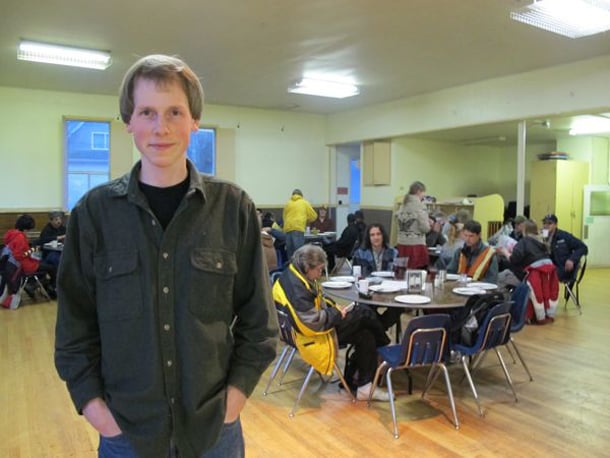There isn't an official seating plan at Calvary Baptist Church's weekly Thursday night supper, but the seniors usually end up at the same table.
"My father was born in 1910," declares one elderly man with thick glasses and grey hair poking out from under his ballcap.
"My mother was born in 1900," responds his neighbour. "And my father was born in 1898."
The dinner conversation winds around to news of the day, which includes the elimination of the penny, and a bizarre story in which millions of loonies and toonies were spilled across a northern Ontario highway after a Brinks truck crashed. And, of course, the food. There is a new cook tonight, and on the menu is Indian butter chicken with turmeric rice and a robust salad of romaine, tomato, cucumber, carrot and feta cheese and a homemade oil and vinegar dressing. A serving dish of each is placed on each of the five tables, which seat about eight people each. The dining room din quiets down as everyone digs in.
The serene dinner scene in this church basement is a far cry from what it was this time last year: 150 people lined up out the door, chaos in the dining hall and, sometimes, verbal or physical fights.
This shift has taken place over the course of the past year. It was a calculated move that has been controversial, both inside and outside of the organization. And, although it may seem strange that a church would want to distance itself from the entrenched idea of charity, that's exactly what Calvary is trying to do.
A 'paradigm shift' away from 'free'
I heard about Calvary from Jonathan Bird, executive director of the City Gate Leadership Forum, a non-profit focused on the role of Christian organizations and churches "in fostering vibrant, sustainable cities."
The overarching goal of the Christian Community Food Network is to get other faith-based organizations on board with what Bird describes as a "paradigm shift" away from ad hoc food charity towards a sustainable local food system.
Faith-based organizations are "aligned with food security idea of sustainability," says Bird. It's important that churches support community gardening and local food, that they offer high-quality nutrition and acknowledge that organic is best, that it matters what happens to food scraps. "Our bodies are our temples," he says.
The goal of the network is also to open up a dialogue about moving away from "free" and supporting local enterprise at the same time. They want to get people involved in a different ways of providing meals, and make connections with the food being grown.
According to Bird, the meal program at Calvary started with a single dinner in 1997, organized by two women in the neighbourhood who had been helped by the church and wanted to give back.
Nine months later, it had become a weekly event modeled after the Out of the Cold program in Toronto. Guests were encouraged to take part in meal preparation and cleanup, and it quickly earned a reputation for being safe, low-key and comfortable environment where good food was served. Pretty soon, the numbers were overwhelming.
"We had no idea there was as much need as there turned out to be," says Bird. "Torpedoed" by their own success, they eventually became the very thing they said they'd wanted to be the alternative to.
'It was crazy'
"A fairly typical soup kitchen," is how Geordan Hankinson describes it. Hankinson, a 24-year-old sociology student, came to Calvary in 2008 as its community meal coordinator. At that time, the church was serving 120 to 150 people every Thursday and had a roster of 200 volunteers who would rotate in and out.
"Lineups in the dining room, lineups down the hall," he says. "The only way to feed that number of people was to have them go through a food lineup. It was crazy."
Adam Smith, who has been coming regularly to Calvary Baptist for meals, and now as a volunteer, concurs. Nobody liked the lineups he says, and things could get uncomfortable. Just a few people under the influence of drugs or alcohol could show up and "suck the air out of things," says Smith. "You know, like at a school dance, when trouble shows up and ruins things for everybody?"
It became a necessity, he says, to concentrate on the quality of relationships instead of on the quantity of people.
Hankinson started reading about food security, looking at the Downtown Eastside Neighbourhood House and the Kitchen Tables project. He came to believe that, while the church was meeting a need, it was also, in a way, disempowering people.
He wrote up a position paper and gave it to the board of the church. "It was a bit of a difficult sell," he says. "The board was very entrenched in the charity model."
Along with Bird, and Karen Giesbrecht of City Gate's Christian Community Food Network, Hankinson got about 50 of the regular soup kitchen visitors in a room and asked them about the meal program. He says he was surprised at how honest and candid everyone was. The general consensus was, that they needed the food, but felt the lineups were humiliating.
The church gave its Thursday night dinner guests one month's notice and a list of alternative free or low-cost food sources in the city, and in April 2011, put its meal program on hiatus. Guests were given the option of taking part in a 12-week community kitchen program instead.
From July to mid-September, about 12 people met every Tuesday to "cook, sit, eat and brainstorm" says Hankinson, about what they wanted the program to be.
The group put together policies and procedures. Now, when someone comes for a meal, they either pay $2 or sign up to help. The jobs that were done by volunteers are now handled people who take part in the meal.
Hankinson says about eight to 10 people pay regularly for the meal, another 30 or 40 sign up for a job.
"This way, people have to work together as peers," says Hankinson. "We've gotten rid of volunteer and guest distinctions. We've flipped that power dynamic. We don't have these people from a middle class background serving these other poor people."
'I've gotten a lot of flak'
The shift has been difficult for Calvary, and somewhat controversial within the wider charity food sector in Vancouver.
"I've gotten a lot of flak for it," admits Hankinson. When he presented what they were doing at a summer 2011 meeting of food service providers in the city, some people were quite critical of the new model, including Judy Graves, a longtime activist on the downtown eastside and the city of Vancouver's advocate for the homeless.
"I have a great deal of concern," Graves tells me over coffee at the JJ Bean in Woodwards building. "There's very little food available to people who are very poor or who have no money in the Commercial Drive area.
"I can understand what they're doing. I can see the value of building community and serving food at the same time. But I know many of the people in the streets in Commercial Drive are not capable of the level of personal organization that it takes. And if we've dropped the number of people who eat by about 100 people, where are those 100 people getting their food?"
Hankinson can't answer that for certain. He does feel that making this change at the church was an admission that, maybe they weren't really doing the greatest thing. Being stuck in a circuit, were they really helping or were they part of a band-aid solution?
"I wonder if we had created a dependency," he says, "distorted people's thinking that food is free, rather than inviting them to participate and to share in those costs that are associated with 'free food.'"
'A more responsible crowd'
Calvary currently spends about $150 on food for each meal, about half what it was when they were serving 150 people per week. Where the church has achieved savings in the amount of money spent on food, it has also committed to paying the people who cook. Four regulars have been trained in Food Safe and take turns cooking once a month, for which they are paid $80.
I meet one of the new cooks, Rian Vita, in the kitchen a couple of hours before the meal is to be served. He's chopping onions to the sounds of ZZ Top spinning on a portable CD player.
Vita tells me he's 35, has been in Vancouver since his late twenties, but grew up in Calgary. He has been coming here regularly for meals for two years, and says the new model makes it a "much more relaxing place to be.”
"Charging two dollars or having to do a chore kind of puts you in with a more responsible crowd," he says.
Vita doesn't entertain notions of becoming a career cook, but likes doing this for his community. A little bit of extra money is nice, too. "I'm not the most employable person in the world," he says. "Like, the only thing I really did for 10 years is work in music and video stores, and now there's no such thing anymore. So I have to learn how to do something else."
I ask him what he thinks of this shift in the church's conception of charity food -- and the word charity itself. Does it offend him, I wonder?
"Not anymore," he says. "I don't think it ever did. The way they describe it is, well, just free meals. You can get a whole list of them. Vancouver's really good for that. I'm not sure about the quality of some of these meals. This is probably the best one I've seen out of the ones that I've been to."
The CCFN identified has identified and mapped 97 food assets within the Christian community -- meals, gardens or cooking programs -- between Vancouver and Langley.
In Vancouver proper, Vancouver Coastal Health has identified 112 locations where free or low-cost meals are provided, which includes both non-secular and faith-based organizations (see map below).
A map of free and low-cost meals in Vancouver, compiled by Vancouver Coastal Health as of 2011. Click here for a larger version.
Still, most in this sector are quick to point out that the solution to hunger is not free meals, but rather a living wage and a route out of poverty. Smith tells me he's been homeless in the past, and during that time he says he felt he could either concentrate on his health, or finding a job. He chose his health.
"If you work," he says, “you're not able to stand in line that day for your lunch, let alone supper."
"I think trying to live on the streets and work is next to impossible." ![]()
Read more: Rights + Justice, Food

















Tyee Commenting Guidelines
Comments that violate guidelines risk being deleted, and violations may result in a temporary or permanent user ban. Maintain the spirit of good conversation to stay in the discussion.
*Please note The Tyee is not a forum for spreading misinformation about COVID-19, denying its existence or minimizing its risk to public health.
Do:
Do not: